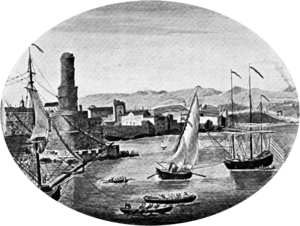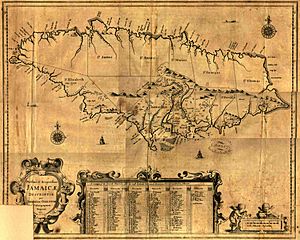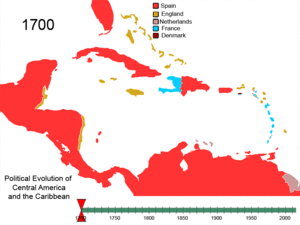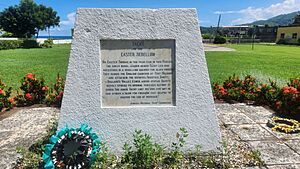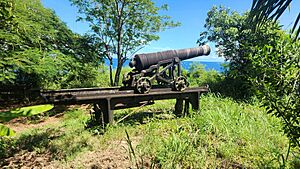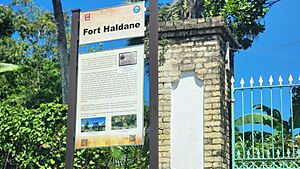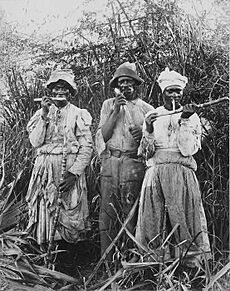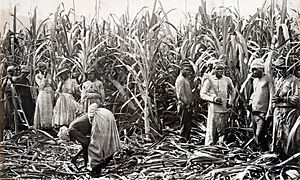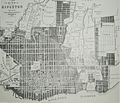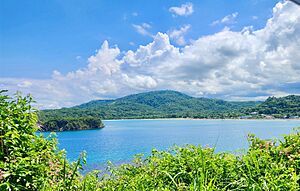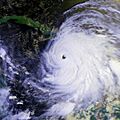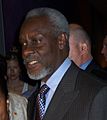History of Jamaica facts for kids
The Caribbean island of Jamaica was first settled around 600 AD or 650 AD by the Redware people, known for their special pottery. Later, around 800 AD, another group called the Arawak tribes, including the Tainos, arrived. They lived on the island before Columbus came in 1494. The early people of Jamaica called their home "Xaymaca," which means "land of wood and water." The Spanish enslaved the Arawak people. Many Arawak also died from diseases brought by the Spanish. Historians once thought the Arawak-speaking Taino tribes were extinct by 1602. However, some Taino escaped into the mountains. There, they mixed with African people who had escaped slavery, living freely away from Spanish and later English rule.
The Spanish also brought many enslaved people from West Africa to the island. But most enslaved Africans were brought to Jamaica by the English.
In 1655, the English took over Jamaica from the Spanish. Some enslaved African people used this chance to escape to the island's mountains. They formed independent groups known as the Maroons. Meanwhile, the English built a town called Port Royal on the coast. This became a busy place where pirates often gathered. Captain Henry Morgan, a Welsh plantation owner and privateer, became famous as one of the richest pirates in the Caribbean. He raided towns and ships from Port Royal.
In the 1700s, sugar cane farming became more important than piracy for British Jamaica's money. Growing sugar needed a lot of workers. So, the British brought hundreds of thousands of enslaved black Africans to the island. By 1850, the black and mixed-race population in Jamaica was 20 times larger than the white population. Enslaved Jamaicans fought back in many major uprisings during the 1700s, like Tacky's Revolt in 1760. There were also fights between the British and the mountain communities of the Jamaican Maroons. These led to the First Maroon War in the 1730s and the Second Maroon War from 1795 to 1796.
The Baptist War showed how bad conditions were for enslaved people. This greatly helped the movement to end slavery. The Slavery Abolition Act 1833 officially ended slavery in Jamaica in 1834. However, relations between white and black communities remained difficult. A major event was the Morant Bay Rebellion in 1865. The late 1800s brought economic problems, low crop prices, droughts, and diseases. When sugar became less important, many plantations went out of business. Land was sold to Jamaican farmers, and British companies bought up many cane fields.
Jamaica's first political parties started in the late 1920s. Workers' groups and trade unions appeared in the 1930s. A new Constitution in 1944 gave all men the right to vote and allowed for some self-government. This eventually led to Jamaican Independence in 1962. Alexander Bustamante became Jamaica's first prime minister. The country grew a lot after the war. It relied less on farming and more on bauxite mining in the 1960s and 1970s. Political power has changed between the two main parties, the JLP and PNP, from the 1970s until today. In 2013, Jamaica faced economic problems. The IMF gave a $1 billion loan to help Jamaica pay its large debts. This made Jamaica a country that spends about half its yearly budget on debt payments.
Contents
- Early People of Jamaica
- Spanish Rule in Jamaica (1494–1655)
- British Rule in Jamaica (1655–1962)
- Independent Jamaica (1962–Present)
- See also
Early People of Jamaica
The first people in Jamaica likely came from islands to the east. They arrived in two main groups. Around 600 CE, a group known as the "Redware people" came. We don't know much about them, except for the red pottery they left behind. Places like Alligator Pond and Little River show where these early people lived. They stayed near the coast and hunted turtles and fish.
Around 800 CE, the Arawak tribes, called the Tainos, arrived. They settled all over the island. They lived in villages led by tribal chiefs called the caciques. They got their food by fishing and growing maize (corn) and cassava. At their peak, there might have been as many as 60,000 Taino people.
The Arawak brought a way of growing yuca (cassava) from South America. To make the soil better, they burned local plants and trees. They then piled the ash into big mounds and planted yuca cuttings there. Most Arawak lived in large round houses called bohios. These were made with wooden poles, woven straw, and palm leaves. The Arawak spoke an Arawakan language and did not have writing. Some of their words are now used in Spanish and English. These include barbacoa ("barbecue"), hamaca ("hammock"), kanoa ("canoe"), tabaco ("tobacco"), yuca, batata ("sweet potato"), and juracán ("hurricane").
-
Caguana Ceremonial Ball Courts Site (batey), outlined with stones in Utuado, Puerto Rico
Spanish Rule in Jamaica (1494–1655)
Christopher Columbus was likely the first European to reach Jamaica. He landed on the island on May 5, 1494, during his second trip to the Americas. Columbus came back to Jamaica on his fourth trip. A storm left his ships stuck in St. Ann's Bay, Jamaica, on June 25, 1503. Columbus and his crew were stranded for a year, finally leaving in June 1504.
The Spanish king gave the island to Columbus's family. For many years, Jamaica was not very important. It was mainly used to supply food and animal hides. In 1509, Juan de Esquivel started the first lasting European town, Sevilla la Nueva (New Seville), on the north coast.
In 1534, the capital moved to Villa de la Vega, later called Spanish Town. This town was the capital for both Spanish and English Jamaica until 1872. Then, the capital moved to Kingston.
The Spanish enslaved many Arawak people. Some escaped to the mountains to join the Maroons. But most died from European diseases and from being forced to work too hard. The Spanish also brought the first enslaved Africans to the island. By the early 1600s, most Taino had died out. The island's population was about 3,000, including a small number of enslaved Africans. The Spanish were disappointed because they found little gold. So, Jamaica was mostly used as a military base to support other colonization efforts.
The Spanish colonists did not bring women on their first trips. They took Taíno women as wives, leading to mestizo (mixed-race) children.
The Taino called the island "Xaymaca." The Spanish slowly changed the name to "Jamaica." In a map from 1507, it was called "Jamaiqua." In a book from 1511, it was called "Jamaica" and "Jamica."
British Rule in Jamaica (1655–1962)
English Takeover in the 1600s
England Conquers Jamaica
In late 1654, England's leader, Oliver Cromwell, sent a large fleet to attack Spain's colonies in the Caribbean. In April 1655, General Robert Venables led an attack on Spain's fort in Santo Domingo. This attack failed. So, the English force sailed to Jamaica. Jamaica was the only Spanish island without new defenses. In May 1655, about 7,000 English soldiers landed near Jamaica's capital, Spanish Town. They quickly defeated the small number of Spanish troops. At that time, Jamaica's whole population was only about 2,500 people.
Spain never took Jamaica back. They lost battles in 1657 and 1658. In 1660, a group of Maroons, led by Juan de Bolas, switched sides. They stopped helping the Spanish and joined the English. This was a key moment in England taking control of the island. For England, Jamaica was meant to be a "dagger pointed at the heart of the Spanish Empire." But at first, it was not very valuable. England officially gained Jamaica from Spain in 1670 with the Treaty of Madrid. This meant they no longer had to constantly defend against Spanish attacks. This encouraged more planting and farming.
British Colonization and Population Changes
Cromwell increased the number of Europeans on the island. He sent workers who had to serve a certain time and also prisoners to Jamaica. Because of wars in Ireland, two-thirds of these Europeans in the 1600s were Irish. But tropical diseases kept the number of Europeans below 10,000 until about 1740. In the 1670s and 1680s, the enslaved African population was never more than 10,000. But by the end of the 1600s, more slaves were brought in. This made the black population at least five times larger than the white population. After that, Jamaica's African population did not grow much until the 1700s. This was partly because ships from Africa preferred to unload in the Eastern Caribbean islands. At the start of the 1700s, there were about 45,000 enslaved people in Jamaica. But by 1800, this number had grown to over 300,000.
Maroons: Freedom Fighters
When the English captured Jamaica in 1655, the Spanish colonists ran away. They left behind many enslaved Africans. These former Spanish slaves formed groups under leaders like Juan de Serras and Juan de Bolas. These Jamaican Maroons married Arawak people. They created their own independent communities in the mountains of Jamaica. They survived by farming for themselves and by sometimes raiding plantations. Over time, the Maroons controlled large parts of Jamaica's interior.
In the second half of the 1600s, de Serras often fought against English colonial forces. He even attacked the capital of Spanish Town. The English never defeated him. Throughout the 1600s and early 1700s, Maroon fighters often beat the British in small battles. The British sent many groups to try and defeat them. But the Maroons successfully fought a guerrilla war against the British in the mountains. This forced the British government to make peace to end the costly fighting.
In the early 1700s, English-speaking escaped Akan slaves were key leaders in the Maroon fight against the British.
Jamaica's Pirates
After the English took over in 1655, Spain tried many times to get Jamaica back. To fight this, in 1657, Governor Edward D'Oyley invited the Brethren of the Coast to make Port Royal their home port. This group of pirates were descendants of cattle hunters. They became pirates after the Spanish robbed them. These pirates mainly attacked Spanish ships. This was because Spanish ships were seen as the biggest threat to Port Royal. These pirates later became legal English privateers. They were given special permission by Jamaica's governor to attack enemy ships. England also started attacking Spanish ships and towns. By using these privateers, England set up a good defense system for Port Royal. Jamaica became a safe place for privateers, buccaneers, and sometimes even regular pirates. Famous ones included Christopher Myngs, Edward Mansvelt, and especially Henry Morgan.
England officially gained Jamaica from Spain in 1670 through the Treaty of Madrid. This meant there was no longer a constant need to defend against Spanish attacks. This encouraged more planting of crops. This agreement also improved the supply of enslaved people. It also gave more protection, including military help, to planters against foreign rivals. Because of this, sugar farming and slave-worked plantations spread across Jamaica in the 1700s. This made Jamaica less dependent on privateers for protection and money.
However, the English authorities still had trouble stopping the Spanish Maroons. These Maroons lived in the mountains and often raided plantations and towns like Spanish Town. The Karmahaly Maroons, led by Juan de Serras, stayed in the forested mountains. They continued to fight the English from time to time. In the 1670s and 1680s, Morgan, who owned a large slave plantation, led three campaigns against the Jamaican Maroons of Juan de Serras. Morgan had some success. The Maroons moved deeper into the Blue Mountains, where Morgan and his forces could not reach them.
Another big blow to Jamaica's link with privateers was the strong earthquake that destroyed much of Port Royal on June 7, 1692. Two-thirds of the town sank into the sea right after the main shock. After the earthquake, the town was partly rebuilt. But the government moved to Spanish Town, which had been the capital under Spanish rule. Port Royal was further damaged by a fire in 1703 and a hurricane in 1722. Most sea trade moved to Kingston. By the late 1700s, Port Royal was mostly empty.
Jamaica's Sugar Boom in the 1700s
In the mid-1600s, sugarcane was brought to the British West Indies from Brazil by the Dutch. When they arrived in Jamaica and other islands, they quickly told local farmers to switch from growing cotton and tobacco to sugarcane. Cotton and tobacco prices were low because of strong competition from North American colonies. So, farmers switched, which led to a big economic boom in the Caribbean. Sugarcane was quickly bought by the British. They used it in cakes and to sweeten tea. In the 1700s, sugar replaced piracy as Jamaica's main way to make money. The sugar industry needed many workers. So, the British brought hundreds of thousands of enslaved Africans to Jamaica. By 1832, a typical plantation in Jamaica had about 150 enslaved people. Nearly one out of every four enslaved people lived on plantations with at least 250 enslaved people.
The 1700s saw thousands of enslaved people brought to Jamaica for the profitable sugar plantations. From 1740 to 1834, the estimated enslaved population kept growing. It reached over 300,000 by the end of the century. Jamaica's sugar boom changed the slave market and the economy of the West Indies. By the late 1700s, Jamaica was the top sugar producer for the British Empire. In 1796, it produced up to 66% of the empire's sugar. The price of sugar went up a lot because there was a huge demand for it in Great Britain, especially among the rich. From 1748 to 1755, the value of sugar exports from Jamaica nearly tripled.
With more ships, sugar, and enslaved people moving around, British merchants started a "guarantee system." A merchant would promise payment when enslaved people were delivered. This helped merchants feel safe. They had no control over the price of enslaved people, which depended on age, weight, and health. With a safe trade system and rising sugar prices, many merchants and sailors came to Jamaica hoping to get rich.
First Maroon War (1739–1740)
Starting in the late 1600s, there were regular fights between the English military and the Windward Maroons. There were also occasional slave revolts. In 1673, a revolt of 200 enslaved people in St. Ann's Parish created a separate group called the Leeward Maroons. These Maroons joined with a group of Madagascars who survived a slave ship wreck. They formed their own Maroon community. More rebellions added to the Leeward group's numbers. In 1690, a revolt of 400 enslaved people at Sutton's plantation greatly strengthened the Leeward Maroons. The Leeward Maroons lived in "cockpits." These were caves or deep valleys that were easy to defend, even against stronger armies. They used guerrilla warfare and scouts who blew the abeng (a cow horn trumpet) to warn of enemies. This helped the Maroons avoid, stop, frustrate, and defeat the British.
In the early 1700s, the Maroons caused heavy losses for the British military sent against them. This became known as the First Maroon War. In 1728, Robert Hunter became governor of Jamaica. His arrival led to more intense fighting. However, even with more soldiers, the British could not defeat the Windward Maroons.
In 1739–40, the British government in Jamaica realized it could not defeat the Maroons. So, they offered peace treaties instead. In 1739, the British, led by Governor Edward Trelawny, made peace with the Leeward Maroon leader, Cudjoe. British planters described Cudjoe as a short, almost dwarf-like man who fought bravely for his people's freedom for years. Some writers say that during the conflict, Cudjoe became less hopeful. He argued with his officers and other Maroon groups. He felt that the only way forward was a peace treaty with the enemy that recognized the Leeward Maroons' independence. In 1742, Cudjoe had to stop a rebellion of Leeward Maroons who were against the treaty.
The First Maroon War ended with an agreement in 1739–1740 between the Maroons and the British government. In return for peace, the Maroons agreed not to hide new runaway slaves. Instead, they would help catch them. This part of the treaty caused problems between the Maroons and the mixed-race population. However, runaway slaves from plantations still sometimes found their way into Maroon settlements. Another part of the agreement was that the Maroons would help protect the island from invaders. This was because the British respected the Maroons as skilled warriors.
A year later, the Windward Maroons, led by Quao, who were even more rebellious, also agreed to sign a treaty. They were pressured by both white Jamaican militias and the Leeward Maroons. Eventually, Queen Nanny also agreed to peace terms for her Maroons.
The Maroons were to stay in their five main towns: Accompong; Cudjoe's Town (Trelawny Town); Nanny Town, later called Moore Town; Scott's Hall (Jamaica); and Charles Town, Jamaica. They would live under their own leaders and a British supervisor.
Tacky's Revolt (1760)
In May 1760, Tacky, an enslaved overseer on the Frontier plantation in Saint Mary Parish, led a group of enslaved Africans. They took over the Frontier and Trinity plantations and killed their enslavers. Then, they marched to the storeroom at Fort Haldane. This was where weapons for defending the town of Port Maria were kept. After killing the storekeeper, Tacky and his men stole nearly four barrels of gunpowder and 40 firearms with shot. Then, they marched on to take over the Heywood Hall and Esher plantations.
By dawn, hundreds of other enslaved people had joined Tacky and his followers. At Ballard's Valley, the rebels stopped to celebrate their success. One enslaved person from Esher decided to sneak away and raise the alarm. Obeahmen (Caribbean spiritual leaders) quickly moved around the camp. They gave out a powder that they said would protect the men from harm in battle. They loudly claimed that an Obeahman could not be killed. Confidence was high. Soon, 70 to 80 mounted militia were on their way. Some Maroons from Scott's Hall also came, as they were bound by treaty to stop such rebellions. When the militia learned of the Obeahman's boast, an Obeahman was captured and killed. Many rebels, their confidence shaken, returned to their plantations. Tacky and about 25 men decided to keep fighting. Tacky and his men ran through the woods. They were chased by the Maroons and their famous marksman, Davy the Maroon.
While running fast, Davy shot Tacky and cut off his head. This was proof of his deed, for which he would be well rewarded. Tacky's head was later displayed on a pole in Spanish Town. A follower took it down in the middle of the night. The rest of Tacky's men were found in a cave near Tacky Falls. They chose to die rather than go back to slavery.
Second Maroon War (1795–1796)
In 1795, the Second Maroon War began. It started when two Maroons were whipped by an enslaved black person for supposedly stealing two pigs. When six Maroon leaders went to the British to complain, the British took them as prisoners. This started an eight-month conflict. The Maroons felt they were being treated badly under the terms of Cudjoe's Treaty of 1739, which ended the First Maroon War. The war lasted for five months as a bloody stalemate. The British colonial authorities could gather 5,000 men, outnumbering the Maroons ten to one. But Jamaica's mountains and forests were perfect for guerrilla warfare. The Maroons surrendered in December 1795. A treaty signed in December between Major General George Walpole and the Maroon leaders stated that the Maroons would beg the King's forgiveness on their knees. They would also return all runaway slaves and be moved to another part of Jamaica. The governor of Jamaica approved the treaty. But he gave the Maroons only three days to show up and beg forgiveness on January 1, 1796. Most Maroons were suspicious of British intentions and did not surrender until mid-March. The British used this delay as an excuse to send all the Trelawny Town Maroons to Nova Scotia. After a few years, the Maroons were again sent to the new British settlement of Sierra Leone in West Africa.
Jamaica in the 1800s
Slave Resistance and Freedom
Hundreds of runaway slaves gained their freedom by escaping and fighting with the Maroons of Trelawny Town. About half of these runaways surrendered with the Maroons. Many were executed or sold back into slavery in Cuba. However, a few hundred stayed in the forests of the Cockpit Country. They joined other runaway communities. In 1798, an enslaved man named Cuffee ran away from a western plantation. He started a runaway community that was able to resist attempts by colonial forces and the remaining Maroons to defeat them. In the early 1800s, records show hundreds of runaway slaves escaping to "Healthshire." They thrived there for several years before being captured by a group of Maroons.
In 1812, a community of runaways began. A dozen men and some women escaped from the sugar plantations of Trelawny into the Cockpit Country. They created a village with the unusual name of Me-no-Sen-You-no-Come. By the 1820s, Me-no-Sen-You-no-Come had between 50 and 60 runaways. The leaders of the community were escaped slaves named Warren and Forbes. Me-no-Sen-You-no-Come also traded a lot with slaves from the north coast. These slaves exchanged their salt provisions with the runaways for their ground provisions. In October 1824, the colonial militias tried to destroy this community. However, the community of Me-no-Sen-You-no-Come continued to thrive in the Cockpit Country until slavery ended in the 1830s.
The Baptist War (1831)
In 1831, Samuel Sharpe, an enslaved Baptist preacher, led a strike. He demanded more freedom and a working wage of "half the going wage rate." When their demands were refused, the strike turned into a full rebellion. This was partly because Sharpe had also prepared with a rebel military group. This group was called the Black Regiment. It was led by an enslaved man known as Colonel Johnson. The Black Regiment had about 150 men and 50 guns. Colonel Johnson's Black Regiment fought with a local militia at old Montpelier on December 28. The militia retreated to Montego Bay. The Black Regiment then moved into plantations in the hills. They invited more enslaved people to join. They burned houses, fields, and other properties, leaving a trail of fires through the Great River Valley.
The Baptist War was the largest slave uprising in the British West Indies. It lasted 10 days and involved as many as 60,000 of Jamaica's 300,000 enslaved people. Colonial forces, led by Sir Willoughby Cotton, stopped the rebellion. The reaction of the Jamaican Government and plantation owners was much more brutal. About 500 enslaved people were killed in total.
End of Slavery (Emancipation)
The British Parliament held two investigations because of the loss of property and lives in the 1831 Baptist War rebellion. Their reports about the conditions of enslaved people greatly helped the movement to end slavery. This led to the Slavery Abolition Act 1833. This act officially ended slavery in Jamaica on August 1, 1834. However, the act said that all enslaved people over the age of 6 on that date had to work for their former owners. This was called the "Apprenticeship System." The time they had to serve depended on their old jobs. "Domestic slaves" owed four years of service, and "agriculture slaves" owed six years. Also, former slave owners were paid for losing their "property." By 1839, "Twenty Million Pounds Sterling" was paid to owners of enslaved people freed in the Caribbean and Africa. Half of these owners lived in Great Britain.
The apprentice system was not popular among Jamaica's "former" slaves. Elderly slaves, unlike slave owners, did not get any money. This led to protests. Because of growing pressure, a decision was made on August 1, 1838. It freed all "apprentices" from their duties to their former masters, no matter their job.
With the end of the slave trade in 1808 and slavery itself in 1834, the island's economy, based on sugar and slaves, struggled. The time after emancipation in 1834 first saw conflict. This was between plantation owners and parts of the Colonial Office. They argued about how much freedom black people should have in politics. In 1840, the assembly changed voting rules. This allowed most black people and people of mixed race to vote. But neither the political changes nor the end of slavery changed the planters' main goal. They still wanted their estates to make money. They continued to control the elite assembly. However, in the late 1800s and early 1900s, the British Crown started allowing some Jamaicans to hold seats on appointed councils. These were mostly local merchants, city professionals, and skilled workers.
The Morant Bay Rebellion (1865)
Tensions between black and white people led to the October 1865 Morant Bay rebellion. This was led by Paul Bogle. The rebellion started on October 7. A black man was put on trial and jailed for supposedly trespassing on an old plantation. During the trial, James Geoghegon, a black person watching, caused a disturbance. When police tried to remove him, a fight broke out between the police and other watchers. While chasing Geoghegon, two policemen were beaten with sticks and stones. The next Monday, arrest warrants were issued for several men. They were wanted for rioting, resisting arrest, and attacking the police. Paul Bogle, a Baptist preacher, was among them. A few days later, on October 11, Mr. Paul Bogle marched with protesters to Morant Bay. When they reached the courthouse, they met a small, untrained volunteer militia. The crowd began throwing rocks and sticks at the militia. The militia fired back, killing seven black protesters before retreating.
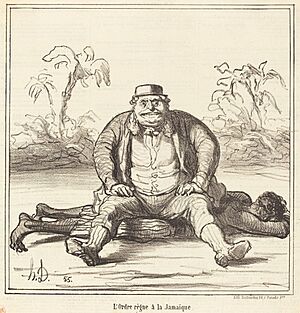
Governor John Eyre sent government troops, led by Brigadier-General Alexander Nelson. Their job was to hunt down the poorly armed rebels and bring Paul Bogle back to Morant Bay for trial. The troops met no organized resistance. In the end, 439 black Jamaicans were killed directly by soldiers. Another 354 people (including Paul Bogle) were arrested and later executed. Some were killed without proper trials. Thousands of homes belonging to black Jamaicans were burned down for no good reason.
George William Gordon, a Jamaican-born plantation owner, businessman, and politician, was the mixed-race son of a Scottish plantation owner and his enslaved black mistress. Gordon had criticized Governor John Eyre and his policies. He was later arrested by the Governor, who believed he was behind the rebellion. Even though he had little to do with the rebellion, Gordon was executed. He was arrested in Kingston but moved by Eyre to Morant Bay. There, he could be tried under martial law (military rule). Gordon's execution and trial under martial law caused questions in Britain. People wondered if British colonies should be ruled by law or by military force. Gordon was hanged on October 23, after a quick trial. He and William Bogle, Paul's brother, "were both tried together, and executed at the same time.”
Sugar Industry Decline
For most of the 1700s, Jamaica's economy relied on growing only sugarcane for export. This system worked well. However, in the last part of the century, the Jamaican sugar economy declined. Famines, hurricanes, colonial wars, and wars for independence disrupted trade. By the 1820s, Jamaican sugar was less competitive than sugar from places like Cuba. Production then dropped. By 1882, sugar output was less than half of what it was in 1828. A big reason for this decline was the British Parliament's 1807 abolition of the slave trade. This law forbade bringing enslaved people to Jamaica after March 1, 1808. The end of the slave trade was followed by the end of slavery in 1834 and full freedom for enslaved people within four years.
Planters could not turn former slaves into a class of tenant farmers. So, they relied more on paid workers. They started hiring workers from other countries, mainly from India, China, and Sierra Leone. Many former slaves settled in farming communities in the island's interior. They grew food for themselves and some crops to sell.
The second half of the 1800s was a tough economic time for Jamaica. Low crop prices, droughts, and disease led to serious social unrest. This ended with the Morant Bay rebellion in 1865. However, new British rule after the 1865 rebellion, as a crown colony, brought some social and economic progress. There was also investment in roads and buildings. Farming development was key to restored British rule. In 1868, the first large irrigation project began. In 1895, the Jamaica Agricultural Society was founded. It aimed to promote better farming methods. Also in the 1890s, the Crown Lands Settlement Scheme started. This land reform program allowed small farmers to buy two hectares or more of land on good terms.
Between 1865 and 1930, land ownership in Jamaica changed a lot as sugar became less important. Many former plantations went bankrupt. Some land was sold to Jamaican farmers under the Crown Lands Settlement. Other cane fields were bought by big British producers, especially Tate & Lyle. While land and wealth concentration was not as extreme as in the Spanish Caribbean, by the 1920s, a typical sugar plantation in Jamaica had grown to an average of 266 hectares. But small-scale farming survived. The number of small farms actually tripled between 1865 and 1930. This meant a large part of the population remained farmers. Most of this growth happened before 1910, with farms averaging between two and twenty hectares.
The rise of the banana trade in the late 1800s also changed farming and trade. Bananas were first exported in 1867. Banana farming grew quickly after that. By 1890, bananas had replaced sugar as Jamaica's main export. Production rose from 5 million stems in 1897 to an average of 20 million stems a year in the 1920s and 1930s. This was over half of all exports. Like with sugar, American companies, such as the famous United Fruit Company, helped drive new agricultural exports.
Jamaica as a Crown Colony
In 1846, Jamaican planters faced a big problem. Britain passed the Sugar Duties Act 1846. This law removed Jamaica's special status as Britain's main sugar supplier. The Jamaica House of Assembly struggled until the sugar trade collapsed. Then, racial and religious tensions exploded during the Morant Bay rebellion of 1865. The rebellion was put down harshly. But the severe riots scared the planters so much that the two-century-old assembly voted to end itself. They asked for direct British rule. In 1866, the new governor, John Peter Grant, arrived. He made many changes that came with becoming a crown colony. The government had a Legislative Council and an executive Privy Council. But the Colonial Office, through a British governor, held the real power. The council included a few chosen Jamaicans just for show. In the late 1800s, crown colony rule changed. Some representation and limited self-rule were slowly brought back after 1884. The colony's laws were reformed to be like English common law. A police force was also created.
Religion in Jamaica
Until 1870, the Church of England was the official church in Jamaica. It represented the white English community. It received money from the colonial government and was responsible for teaching religion to enslaved people. Methodist missionaries from England challenged it. These Methodists were then called troublemakers. The Church of England in Jamaica started the Jamaica Home and Foreign Missionary Society in 1861. Its mission stations grew with financial help from religious groups in London. The Society sent its own missionaries to West Africa. Baptist missions grew quickly, thanks to missionaries from England and the United States. They became the largest religious group by 1900. Baptist missionaries said the apprentice system was a form of slavery. In the 1870s and 1880s, the Methodists opened a high school and a college for religious studies. Other Protestant groups included Moravians, Presbyterians, Congregationalists, Seventh-day Adventists, and the Church of God. There were also several thousand Roman Catholics. By 1900, most people were Christian. Most families were connected to a church or Sunday School. Old traditional practices, like witchcraft, still existed in an unorganized way.
Kingston Becomes the Capital
In 1872, the government passed a law to move government offices from Spanish Town to Kingston. Kingston was founded as a safe place for people who survived the 1692 Jamaica earthquake that destroyed Port Royal. The town did not start to grow until Port Royal was further destroyed by fire in 1703. Surveyor John Goffe made a plan for the town. It was based on a grid and bordered by North, East, West, and Harbour Streets. By 1716, it had become the largest town and the center of trade for Jamaica. The government sold land to people. The rule was that they could not buy more land than they owned in Port Royal, and only land on the sea front. Slowly, wealthy merchants started moving their homes from above their businesses to the farmlands north on the plains of Liguanea. In 1755, the governor, Sir Charles Knowles, decided to move the government offices from Spanish Town to Kingston. Some thought it was not a good place for the Assembly because of the "moral distractions" of Kingston. The next governor canceled the law. However, by 1780, Kingston's population was 11,000. Merchants began asking for the capital to be moved from Spanish Town. Spanish Town was by then much smaller than Kingston in terms of business. The 1907 Kingston earthquake destroyed much of the city. Many writers at that time called it one of the world's deadliest earthquakes. It killed over 800 Jamaicans and destroyed the homes of over 10,000 more.
Early 1900s in Jamaica
Banana Trade Grows
The first modern plantations started in Jamaica and nearby Central America. This happened because new ways of transport, like steamships and railroads, combined with refrigeration. This allowed bananas to be harvested and then ripen later. North American shippers like Lorenzo Dow Baker and Andrew Preston, who started the Boston Fruit Company, began this in the 1870s. Railroad builders like Minor C. Keith also joined in. This eventually led to huge global companies like today's Chiquita Brands International and Dole. These companies were monopolies. This means they controlled everything: growing, processing, shipping, and selling. They often used political influence to create special economies. These economies were self-sufficient, almost tax-free, and focused on exports. They contributed very little to Jamaica's own economy. Alfred Constantine Goffe was a Jamaican businessman. His St. Mary Banana co-op was the first in Jamaica. He opposed the larger export companies. By 1909, he had the largest Jamaican-owned banana export company.
Marcus Garvey: A National Hero
Marcus Mosiah Garvey, a black activist and Trade Unionist, started the Universal Negro Improvement Association and African Communities League in 1914. He also founded one of Jamaica's first political parties in 1929 and a workers' association in the early 1930s. Garvey also supported the Back-to-Africa movement. This movement encouraged people of African descent to return to their ancestors' homelands. Garvey was a controversial figure. The United States government investigated him for four years. He was found guilty of mail fraud in 1923. After serving most of a five-year sentence, he was sent back to Jamaica in 1927. Garvey left Jamaica in 1935 to live in the United Kingdom. He died there five years later, deeply in debt. In the 1960s, he was named Jamaica's first national hero. This happened after Edward P.G. Seaga, then a government minister, arranged for his remains to be brought back to Jamaica. In 1987, Jamaica asked the United States Congress to pardon Garvey. They argued that the charges against him were unfair.
Rastafari Movement
The Rastafari movement, a new religion, began among poor and struggling Afro-Jamaican communities in the 1930s. Its ideas, focused on African heritage, were a reaction against Jamaica's strong British colonial culture at the time. It was influenced by Ethiopianism and the Back-to-Africa movement promoted by black leaders like Marcus Garvey. The movement grew after several Christian preachers, especially Leonard Howell, said that the crowning of Haile Selassie as Emperor of Ethiopia in 1930 fulfilled a Bible prophecy. By the 1950s, Rastafari's different way of life caused problems with wider Jamaican society. This included violent clashes with police. In the 1960s and 1970s, it gained more respect in Jamaica and became more known around the world. This was thanks to popular Rasta-inspired reggae musicians like Bob Marley and Peter Tosh. Interest in Rastafari decreased in the 1980s after the deaths of Haile Selassie and Marley.
Great Depression and Worker Protests
The Great Depression caused sugar prices to drop in 1929. This led many Jamaicans to return home. Economic problems, unhappiness with unemployment, low wages, high prices, and poor living conditions caused social unrest in the 1930s. Uprisings in Jamaica started at the Frome Sugar Estate in Westmoreland and quickly spread east to Kingston. Jamaica, in particular, led the way in demanding economic development from British colonial rule.
Because of problems in Jamaica and other parts of the region, the British in 1938 appointed the Moyne Commission. An immediate result was the Colonial Development Welfare Act. This act provided about £1 million a year for twenty years for development in the British West Indies. However, real actions were not taken to fix Jamaica's big structural problems.
New Unions and Parties
The growth of nationalism, meaning a strong feeling of national identity, is usually linked to the 1938 labor riots. These riots affected both Jamaica and the Eastern Caribbean islands. William Alexander Bustamante (formerly William Alexander Clarke) was a moneylender in Kingston. He had formed the Jamaica Trade Workers and Tradesmen Union (JTWTU) three years earlier. He captured the attention of the black masses with his powerful personality, even though he was light-skinned, rich, and from a high social class. Bustamante became a popular leader after the 1938 strikes. He was the main voice for the strong urban working class. In that year, using the JTWTU as a starting point, he founded the Bustamante Industrial Trade Union (BITU). This union started Jamaica's workers' movement.
Norman W. Manley, Bustamante's cousin, realized from the 1938 riots that true national unity in Jamaica came from the common people. Unlike Bustamante, who focused on unions, Manley was more interested in gaining political power and political rights for the masses. On September 18, 1938, he started the People's National Party (PNP). This party began as a nationalist movement. It was supported by Bustamante, the mixed-race middle class (including educated people), and liberal business owners. The 1938 riots pushed the PNP to form labor unions. However, it took several years for the PNP to create major labor unions. The party first focused on building support in cities and in banana-growing rural parishes. Later, they worked on gaining support among small farmers and in areas where bauxite mining took place.
The PNP adopted a socialist ideology in 1940. They later joined the Socialist International, linking with social democratic parties in Western Europe. Manley was guided by socialist ideas but was not a strict socialist. PNP socialism in the 1940s was similar to British Labour Party ideas. These included state control of production, equality of opportunity, and a welfare state. However, a left-wing part of the PNP had more traditional Marxist views. They worked to make the trade union movement international through the Caribbean Labour Congress. In these early years of Jamaican politics and union activity, Manley and Bustamante got along well. Manley defended Bustamante in court against charges from the British for his labor activism in the 1938 riots. He also looked after the BITU while Bustamante was in prison.
Bustamante had his own political goals. In 1942, while still in prison, he founded a political party to compete with the PNP. It was called the Jamaica Labour Party (JLP). This new party's leaders were from a lower social class than those of the PNP. It was supported by conservative business people and 60,000 paying BITU members. These members included dock workers, sugar plantation workers, and other unskilled urban laborers. After his release in 1943, Bustamante began building up the JLP. Meanwhile, several PNP leaders organized the left-leaning Trade Union Congress (TUC). So, from early on in modern Jamaica, unionized labor was a key part of organized political life.
For the next 25 years, Bustamante and Manley competed for power in Jamaican politics. Bustamante championed the cause of the "barefoot man." Manley promoted "democratic socialism," a general idea aimed at creating a classless government. Jamaica's two founding fathers had very different public images. Bustamante, who didn't even finish high school, was an autocratic, charming, and very skilled politician. Manley was an athletic, Oxford-trained lawyer, Rhodes scholar, humanist, and liberal intellectual. Though much more reserved than Bustamante, Manley was well-liked and respected. He was also a visionary nationalist who pushed for the crown colony's independence.
After the 1938 problems in the West Indies, London sent the Moyne Commission to study conditions in the British Caribbean territories. Its findings led to better wages and a new constitution in the early 1940s. The Constitution, issued on November 20, 1944, changed the crown colony system. It started limited self-government based on the Westminster model of government and universal adult suffrage (the right for all adults to vote). It also included the island's principles of ministerial responsibility and the rule of law. Thirty-one percent of the population voted in the 1944 elections. The JLP won. They promised to create jobs, gave public money to areas that supported them, and the PNP's platform was seen as too radical. The JLP won an 18 percent majority of the votes over the PNP. They also won 22 seats in the 32-member House of Representatives. The PNP got 5 seats, and other short-lived parties got 5. In 1945, Bustamante became Jamaica's first premier (the title for head of government before independence).
Under the new rules, the British governor, helped by a six-member Privy Council and a 10-member Executive Council, remained responsible only to the British Crown. The Jamaican Legislative Council became the upper house, or Senate, of the two-house Parliament. House members were elected by adult voters from single voting areas called constituencies. Despite these changes, the governor and other high officials still held the most power.
Independent Jamaica (1962–Present)
The 1960s: Road to Independence
Jamaica Becomes Independent
After World War II, Jamaica began a relatively long journey to full political independence. Jamaicans preferred British culture over American. But they had a difficult relationship with the British and disliked British control, racism, and the strict Colonial Office. Britain slowly gave the colony more self-government through changes to its constitution. Jamaica's political patterns and government structure were formed during 20 years of "constitutional decolonisation." This was the period between 1944 and independence in 1962.
The PNP saw that their 1944 campaign ideas were not popular. So, the party moved towards the center in 1949 and stayed there until 1974. The PNP actually won 0.8 percent more votes than the JLP in the 1949 election. But the JLP won more seats in the House. In the 1950s, the PNP and JLP became more similar in their members and ideas. During the cold war years, socialism became a hot topic in Jamaica. The JLP used this to gain support from property owners and churchgoers. This attracted more middle-class support. As a result, PNP leaders softened their socialist talk. In 1952, the PNP improved its image by expelling four important leftists who controlled the TUC. The PNP then formed the more moderate National Workers Union (NWU). From then on, PNP socialism meant little more than national planning within a system of private property and foreign money. However, the PNP kept a basic commitment to socialist ideas, like public control of resources and fairer income distribution. Manley's PNP came to power for the first time after winning the 1955 elections. They had an 11 percent majority over the JLP and 50.5 percent of the popular vote.
Changes to the constitution in May 1953 reorganized the Executive Council. They allowed for eight ministers to be chosen from House members. The first government ministries were then created. These changes also increased the limited powers of the House of Representatives. They made elected members of the governor's executive council responsible to the legislature. Manley, who became chief minister in January 1955, sped up the process of decolonization during his good leadership. More progress towards self-government was made with constitutional changes in 1955 and 1956. A cabinet government was set up on November 11, 1957.
British leaders said that independence would be given to a group of West Indian states, not to individual colonies. So, Manley supported Jamaica joining nine other British territories in the West Indies Federation. This federation was created on January 3, 1958. Manley became the island's premier after the PNP won another big victory in the general election in July 1959. They secured 30 out of 45 House seats.
Being part of the federation remained a big issue in Jamaican politics. Bustamante, who had supported it before, changed his mind. He warned about the financial costs of membership. Jamaica was responsible for 43 percent of its own funding. He also pointed out that Jamaica was not fairly represented in the federation's House of Assembly. Manley's PNP wanted to stay in the federation. But he agreed to hold a vote in September 1961 to decide the issue. When 54 percent of voters chose to leave, Jamaica left the federation. The federation then broke up in 1962 after Trinidad and Tobago also left. Manley believed that the rejection of his pro-federation policy in the 1961 vote meant he needed a new vote from the people. But the JLP won the election of early 1962 by a small amount. Bustamante became premier that April. Manley spent his last few years in politics as the leader of the opposition.
Jamaica gained its independence on August 6, 1962. The new nation, however, remained a member of the Commonwealth of Nations. This is an organization of former British territories. Jamaica continues to be a Commonwealth realm, with the British monarch as King of Jamaica and head of state.
Jamaica Under Bustamante
Bustamante then became the first Prime Minister of Jamaica. The island country joined the Commonwealth of Nations, an organization of former British territories. Jamaica is still a Commonwealth realm, with the British monarch as King of Jamaica and head of state.
A long period of growth after the war changed Jamaica into a more industrial society. This sped up with the export of bauxite starting in the 1950s. The economy changed. In 1950, farming made up 30.8 percent of the country's total income. This dropped to 12.9 percent in 1960 and 6.7 percent in 1970. During the same time, mining's contribution to the total income grew from less than 1 percent in 1950 to 9.3 percent in 1960 and 12.6 percent in 1970.
Bustamante's government also continued to crack down on Rastafarians. A notable example was the Coral Gardens incident. After a violent clash between Rastafarians and police at a gas station, Bustamante ordered the police and military to "bring in all Rastas, dead or alive." 54 years later, after a government investigation, the Jamaican government apologized. They took full responsibility for Bustamante's government's actions. They also gave significant money to the remaining survivors of the incident.
Donald Sangster and Hugh Shearer
Bustamante was followed as prime minister in February 1967 by Donald Sangster. Sangster died in office that same year. Hugh Shearer, who was close to Bustamante, took over from Sangster. He served from 1967 to 1972. Money invested in tourism, bauxite mining, and light manufacturing industries helped the economy grow.
In October 1968, the Shearer government stopped Dr. Walter Rodney from returning to his teaching job at the University of the West Indies. This led to the "Rodney riots." These riots were part of a growing black consciousness movement in the Caribbean.
Reggae Music
Jamaica's reggae music grew from Ska and rocksteady in the 1960s. The change from rocksteady to reggae was shown by the organ shuffle. Jamaican musicians like Jackie Mittoo and Winston Wright started this. It was heard in songs like "Say What You're Saying" (1967) by Clancy Eccles and "People Funny Boy" (1968) by Lee "Scratch" Perry. The Pioneers' 1968 song "Long Shot (Bus' Me Bet)" is thought to be the first recorded example of the new reggae sound.
The first true reggae records came out in early 1968. These included "Nanny Goat" by Larry Marshall and "No More Heartaches" by The Beltones. That same year, the new Jamaican sound started to be copied by famous artists in other countries. American artist Johnny Nash's 1968 hit "Hold Me Tight" is said to be the first reggae song to appear on American music charts. Around the same time, reggae influences started showing up in rock and pop music. One example is "Ob-La-Di, Ob-La-Da" by The Beatles in 1968. Other important reggae pioneers include Prince Buster, Desmond Dekker and Ken Boothe.
Bob Marley: Reggae Icon
The Wailers, a band started by Bob Marley, Peter Tosh and Bunny Wailer in 1963, is perhaps the most famous band that went through all three stages of early Jamaican popular music: ska, rocksteady, and reggae. The Wailers released some of the earliest reggae records with producer Lee Scratch Perry. After the Wailers broke up in 1974, Marley started a solo career. This led to his album Exodus in 1977. This album made him famous worldwide and one of the world's best-selling artists of all time, with over 75 million records sold. He was a dedicated Rastafari who filled his music with spiritual meaning.
The 1970s and 1980s
Michael Manley's Leadership
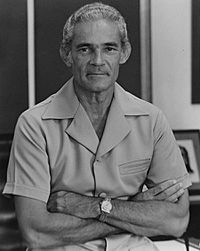
In the 1972 election, the PNP's Michael Manley defeated the JLP's unpopular Prime Minister Hugh Shearer. Under Manley, Jamaica set a minimum wage for all workers, including those who worked in homes. In 1974, Manley suggested free education from primary school to university. Making secondary education free for everyone was a big step. It removed barriers that stopped people from getting private sector and government jobs that needed secondary diplomas. The PNP government also started the Jamaica Movement for the Advancement of Literacy (JAMAL) in 1974. This program offered adult education with the goal of helping 100,000 adults each year.
Land reform grew under his government. Historically, land ownership in Jamaica was very unequal. Project Land Lease, started in 1973, tried a new approach. It gave tens of thousands of small farmers land, technical advice, things like fertilizers, and access to loans. About 14 percent of unused land was given out through this program. Much of this land had been left empty after people moved to cities or was bought by large bauxite companies.
The minimum voting age was lowered to 18. Equal pay for women was introduced. Maternity leave was also started. The government made it illegal to treat children born outside of marriage differently. The Master and Servant Act was ended. A Labour Relations and Industrial Disputes Act gave workers and their trade unions more rights. The National Housing Trust was set up. This gave "most employed people the means to own their own homes." It greatly boosted house building, with over 40,000 houses built between 1974 and 1980.
Subsidized meals, transportation, and uniforms for schoolchildren from poor backgrounds were introduced. Free education was provided at primary, secondary, and university levels. Special job programs were also launched, along with programs to fight illiteracy. Pensions and aid for the poor were increased. Local government taxes were reformed. Youth training was expanded, day care centers were improved, and hospitals were upgraded.
A worker's participation program was started, along with a new mental health law and the family court. Free health care for all Jamaicans was introduced. Health clinics and a paramedic system were set up in rural areas. Various clinics were also created to make it easier to get medicines. Spending on education greatly increased. The number of doctors and dentists in the country also rose.
One Love Peace Concert
The One Love Peace Concert was a big concert held in Kingston on April 22, 1978. This was during a time of political conflict in Jamaica between the rival Jamaican Labour Party and the People's National Party. The concert reached its peak during Bob Marley & The Wailers' performance of "Jammin'." During this song, Marley joined the hands of political rivals Michael Manley (PNP) and Edward Seaga (JLP).
Edward Seaga's Time as Prime Minister
In the 1980 election, Edward Seaga and the JLP won by a huge majority. They got 57 percent of the popular vote and 51 of the 60 seats in the House of Representatives. Seaga immediately started changing his predecessor's policies. He privatized industries and sought closer ties with the USA. Seaga was one of the first foreign leaders to visit newly elected US president Ronald Reagan early the next year. He was also one of the people who helped create the Caribbean Basin Initiative, supported by Reagan. He waited a year to cut diplomatic ties with Cuba. He did so when he accused the Cuban government of giving shelter to Jamaican criminals.
Seaga supported the fall of the Marxist government in Grenada. He also supported the US-led invasion of that island in October 1983. After the Grenada invasion, Seaga called quick elections at the end of 1983. Manley's PNP boycotted these elections. So, Seaga's party controlled all seats in parliament. This was unusual because the Jamaican constitution required an opposition in the appointed Senate. Seaga appointed eight independent senators to form an official opposition.
Seaga lost much of his US support when he could not deliver on his early promises to remove the bauxite tax. His support at home also dropped sharply. Riots in 1987 and 1988, Michael Manley's continued popularity, and complaints about government's poor handling of Hurricane Gilbert in 1988, also led to his defeat in the 1989 elections.
Hurricane Gilbert (1988)
In 1988, Hurricane Gilbert caused a 19 ft (5.8 m) storm surge. It brought up to 823 millimetres (32.4 in) of rain in Jamaica's mountains, causing flash flooding inland. 49 people died. Prime Minister Edward Seaga said that the hardest hit areas, where Gilbert landed, looked "like Hiroshima after the atom bomb." The storm caused US$4 billion (in 1988 dollars) in damage. This included destroyed crops, buildings, houses, roads, and small aircraft. Two people had to be rescued from mudslides caused by Gilbert and were sent to the hospital. They were reported to be fine. No planes were flying in and out of Kingston. Telephone lines were jammed from Jamaica to Florida.
As Gilbert hit Kingston, its winds knocked down power lines, uprooted trees, and flattened fences. On the north coast, 20 feet (6.1 m) waves hit Ocho Rios, a popular tourist resort. Hotels there were evacuated. Kingston's airport reported severe damage to its aircraft. All flights to Jamaica were canceled at Miami International Airport. Unofficial estimates say at least 30 people were killed across the island. Estimated property damage reached over $200 million. More than 100,000 houses were destroyed or damaged. The country's banana crop was mostly wiped out. Hundreds of miles of roads and highways were also badly damaged. Reconnaissance flights over remote parts of Jamaica reported that 80 percent of the homes on the island had lost their roofs. The poultry industry was also destroyed. Damage from agricultural loss reached $500 million (1988 USD). Hurricane Gilbert was the most destructive storm in Jamaica's history. It was the worst storm since Hurricane Charlie in 1951.
Jamaica's Film Industry Begins
Jamaica's film industry started in 1972 with the movie The Harder They Come. It was the first full-length film made by Jamaicans. It starred reggae singer Jimmy Cliff. Perry Henzell directed it, and Island Records founder Chris Blackwell produced it. The film is famous for its reggae soundtrack. It is said to have "brought reggae to the world." Other popular Jamaican films include Smile Orange (1976), Countryman (1982), The Lunatic (1991), Dancehall Queen (1997), and Third World Cop (1999). Important people in the Jamaican film industry include actors PaulCampbell and Carl Bradshaw, actress Audrey Reid, and producer Chris Blackwell.
The 1990s and 2000s
18 Years of PNP Rule
-
Michael Manley, Prime Minister from 1989 to 1992 (his second term)
-
P. J. Patterson, Prime Minister from 1992 to 2006
-
Portia Simpson-Miller, Prime Minister from 2006 to 2007 (her first term) and from 2012 to 2016
The 1989 election was the first election the People's National Party (PNP) took part in since 1980. They had boycotted the 1983 snap election. Prime Minister Edward Seaga announced the election date on January 15, 1989, at a rally in Kingston. He said the emergency conditions caused by Hurricane Gilbert in 1988 were why he extended the government's term beyond its usual five years.
The election date and mood were partly shaped by Hurricane Gilbert. It hit in September 1988 and badly damaged the island. The hurricane caused almost $1 billion in damage. Banana and coffee crops were destroyed, and thousands of homes were lost. Both parties campaigned by giving out relief supplies. This was a common practice in Jamaica. Political experts noted that before the hurricane, Edward Seaga and the JLP were 20 points behind Michael Manley and the PNP in polls. Being the party in charge and able to provide relief allowed Seaga to improve his standing with voters. However, scandals about the relief efforts cost Seaga and the JLP some of the gains they made right after the hurricane.
The election showed less difference in economic ideas between the two parties. Michael Manley made his comeback campaign by softening his left-wing views. He admitted mistakes he made as prime minister. He said he was wrong to involve the government in making goods and had given up all thoughts of taking over industries. He stated the PNP wanted to continue the JLP government's market-focused policies, but with more public involvement. Prime Minister Edward Seaga ran on his record of economic growth and lower unemployment in Jamaica. His campaign slogan was "Don't Let Them Wreck It Again," referring to Manley's previous time as prime minister. Seaga had focused on cutting government spending. He cut almost 27,000 public sector jobs in 1983 and 1984. As elections neared, he changed his plans. He promised to spend J$1 billion on a five-year Social Well-Being Programme. This would build new hospitals and schools in Jamaica. Foreign policy also played a role in the 1989 election. Prime Minister Edward Seaga highlighted his good relations with the United States. This relationship brought Jamaica a lot of economic aid from the U.S. and loans from international groups. Manley promised better relations with the United States. At the same time, he pledged to restore diplomatic relations with Cuba, which Seaga had cut. With Manley as prime minister before, Jamaican-American relations had become strained because of Manley's economic policies and close ties with Cuba.
The PNP won the election. Manley's second term focused on making Jamaica's economy more open. He followed a free-market plan, which was very different from his first government's policies. However, various steps were taken to lessen the negative effects of these changes. A Social Support Programme was started. It provided welfare help for poor Jamaicans. The program also focused on creating jobs, training, and loans for many people. The government also announced a 50% increase in food stamps for the most vulnerable groups. These included pregnant women, nursing mothers, and children. A small number of community councils were also created. In addition, a limited land reform program was carried out. It leased and sold land to small farmers, and land plots were given to hundreds of farmers. The government also had a good record in providing housing. Steps were also taken to protect consumers from illegal and unfair business practices.
In 1992, citing health reasons, Manley stepped down as prime minister and PNP leader. His former Deputy Prime Minister, Percival Patterson, took both offices. Patterson worked to strengthen the country's social protection and security systems. This was a key part of his economic and social plan to reduce poverty. His large investments in modernizing Jamaica's infrastructure and fixing the country's financial sector are widely seen as leading to Jamaica's biggest period of investment in tourism, mining, ICT, and energy since the 1960s. He also ended Jamaica's 18-year borrowing relationship with the International Monetary Fund. This gave the country more freedom in its economic policies.
Patterson led the PNP to big wins in the 1993 and 1997 elections. Patterson called the 1997 election in November 1997. His People's National Party was ahead in the opinion polls. Inflation had fallen a lot, and the national football team had just qualified for the 1998 World Cup. The previous election in 1993 had seen the People's National Party win 52 of the 60 seats.
A record 197 candidates ran in the election. A new political party, the National Democratic Movement, ran in most of the seats. The National Democratic Movement was founded in 1995 by Bruce Golding, a former Labour Party chairman. He left after a disagreement over the leadership of the Jamaica Labour Party.
The 1997 election was mostly free of violence compared to earlier elections. However, it started with an incident where rival groups from the main parties were shot at. This election was the first in Jamaica where a team of international election monitors attended. The monitors were from the Carter Center. They included Jimmy Carter, Colin Powell, and former heavyweight boxing world champion Evander Holyfield. Just before the election, the two main party leaders made a joint appeal for people to avoid violence. Election day itself saw one death and four injuries related to the election. But the 1980 election had seen over 800 deaths.
By winning the election, the People's National Party became the first party to win three times in a row. The opposition Jamaica Labour Party only had two more seats in Parliament after the election. But their leader, Edward Seaga, held his seat for the ninth time in a row. The National Democratic Movement did not win any seats, even though it was predicted they would win one before the election.
The 2002 election was a victory for the People's National Party. But their number of seats fell from 50 to 34 (out of 60 total). PNP leader P. J. Patterson kept his position as Prime Minister. He became the first political leader to win three elections in a row. Patterson stepped down on February 26, 2006. He was replaced by Portia Simpson-Miller, Jamaica's first female prime minister.
The 2007 elections were originally planned for August 27, 2007. But they were delayed to September 3 because of Hurricane Dean. The first results showed a small win for the opposition Jamaican Labour Party led by Bruce Golding. They gained two seats, going from 31–29 to 33–27 after official recounts. The JLP defeated the People's National Party after 18 years of continuous rule.
Economic Challenges
In the 1990s, Jamaica and other Caribbean banana producers wanted to keep their special access to EU markets, especially the United Kingdom. They worried that without it, the EU would be filled with cheap bananas from Central American plantations. This would badly hurt several Caribbean economies. Talks in 1993 led to the EU agreeing to keep the Caribbean producers' special access until the end of Lomé IV. In 1995, the United States government asked the World Trade Organization to check if the Lomé IV agreement broke WTO rules. In 1996, the WTO ruled in favor of the US. This effectively ended the special payments that had helped African, Caribbean, and Pacific (ACP) countries for many years. But the US was still not happy. They insisted that all special trade agreements between the EU and ACP should stop. The WTO set up another group to discuss this. It concluded that the agreements between the EU and ACP were indeed not allowed under WTO rules. Finally, the EU talked with the US through the WTO to reach an agreement.
In tourism, after a drop in visitors following the 11 September attacks in the U.S., the number of tourists to Jamaica eventually recovered. Now, the island gets over a million tourists each year. Services now make up over 60 percent of Jamaica's total income. One out of every four workers in Jamaica works in tourism or services. However, according to the World Bank, about 80% of the money tourism makes in Jamaica does not stay on the island. Instead, it goes to large international resorts.
Cricket World Cup and Olympics
The 2007 Cricket World Cup was the first time the ICC Cricket World Cup was held in the Caribbean. The Jamaican Government spent US$81 million for "on the pitch" expenses. This included fixing up Sabina Park and building the new multi-purpose facility in Trelawny. This was done with a loan from China. Another US$20 million was planned for "off-the-pitch" expenses. This brought the total to over US$100 million or JM$7 billion. The cost to rebuild Sabina Park was US$46 million, while the Trelawny Stadium cost US$35 million. The total money spent on stadiums was at least US$301 million.
In sprinting, Jamaicans began to dominate the 100 meters world record in 2005. Jamaica's Asafa Powell set the record in June 2005 and held it until May 2008, with times of 9.77 and 9.74 seconds. However, at the 2008 Summer Olympics in Beijing, Jamaica's athletes reached new heights. They nearly doubled the country's total gold medal count. They also broke the nation's record for the number of medals won in a single game. Usain Bolt won three of Jamaica's six gold medals in Beijing. He broke an Olympic and world record in all three events he was in. Shelly-Ann Fraser led an amazing Jamaican sweep of the medals in the Women's 100 m.
Dancehall Music Goes Global
Although Jamaican dancehall music started in the late 1970s, it became much more popular in the late 1980s and 1990s. At first, dancehall was a simpler version of reggae than the roots style that was popular in the 1970s. Two of the biggest stars of early dancehall were Yellowman and Eek-a-Mouse. Dancehall brought a new group of producers, including Linval Thompson, Gussie Clarke, and Jah Thomas. In the mid-1980s, digital instruments became more common. This changed the sound a lot. Digital dancehall (or "ragga") became known for faster rhythms.
In the early 1990s, songs by Dawn Penn, Shabba Ranks, Patra, and Chaka Demus and Pliers were the first huge dancehall hits in the US and other countries. Other types of dancehall also became popular outside of Jamaica in the mid-to-late 1990s.
The early 2000s saw the success of newer artists like Elephant Man, Tanya Stephens, and Sean Paul. Dancehall became popular again in the pop music market in the late 2000s. This was with songs by Konshens, Mr. Vegas, Popcaan, Mavado, Vybz Kartel, Beenie Man, and others.
More Economic Troubles
In 2013, the International Monetary Fund announced a $1 billion loan to help Jamaica pay its large debts. The loan required the Jamaican government to freeze pay, which meant a 20% cut in real wages. Jamaica is one of the most indebted countries. It spends about half of its yearly government budget on debt payments.
The 2010s look like a difficult time for Jamaica's sugarcane industry. After a short increase in sugar prices, the future for Jamaican sugar took a hit in 2015. This was when the EU started to end a limit on European sugar beet production. Jamaica exports 25% of its sugar to Britain. Prices for Jamaican sugar are expected to fall after the EU's subsidized sugar beet industry no longer has a cap.
2016 Election
In February 2016, the opposition Labour Party won a close victory in the general election. Prime Minister Portia Simpson Miller of the People's National Party was replaced by Andrew Holness, the leader of the Labour Party.
COVID-19 Pandemic in Jamaica
The COVID-19 pandemic was confirmed in Jamaica on March 10, 2020. This happened during the 2019–2020 dengue fever epidemic that affected Latin America and the Caribbean.
The government announced a travel ban between China and Jamaica. All people entering Jamaica from China would be immediately quarantined for at least 14 days. Anyone allowed to land who showed symptoms of the virus would be put in immediate isolation. Following this new rule, 19 Chinese nationals who arrived at the Norman Manley International Airport on January 31 were not allowed to enter. They were quarantined and put on a flight back to China on February 1.
On January 11, 2022, Jamaica had more confirmed cases than China.
On March 10, the Ministry of Health and Wellness (MoHW) confirmed the first case in Jamaica. It was a female patient who arrived from the United Kingdom on March 4. The health minister reported that the patient had been in isolation since March 9 after showing breathing problems. After this update, the travel ban was expanded to include France, Germany, and Spain.
On March 11, the country's health minister, Christopher Tufton, confirmed the second "imported corona virus" case.
On March 13, the country announced six more cases. These included the father and another female patient of the first patient. Later that day, the government announced that the community of Bull Bay – where the first patient attended a funeral – was placed under quarantine for 14 days. Four of the cases involved patients traveling through or from the United Kingdom. So, the country's foreign minister Kamina Johnson-Smith announced that the travel ban would be expanded to include the United Kingdom.
On March 15, the Ministry of Health and Wellness (MoHW) confirmed that 19 suspected cases were reported and tested. Of these 19, only two patients were confirmed to have the virus. One came from Trinidad and Tobago, and the other had "contact tracing from the index case" (the first known case). In the same update, the Ministry confirmed that 27 patients were in isolation facilities. Patients 1 and 2 no longer showed any symptoms.
On March 16, the Ministry of Health and Wellness (MoHW) and the Office of the Prime Minister (OPM) reported that there were five preliminary confirmed cases. Later that day, the government confirmed that only two of the five reported cases tested positive for COVID-19. Because of the increase in cases, the government announced more social distancing rules. These included telling people to work from home, banning all large gatherings of more than 20 people, and closing bars, restaurants, and sporting events.
2020 Election
In September 2020, the ruling center-right Labour Party won a huge victory in the general election. It took 49 of 63 parliamentary seats. This meant the current Prime Minister Andrew Holness would serve a second term.
See also
 In Spanish: Historia de Jamaica para niños
In Spanish: Historia de Jamaica para niños
- Colony of Jamaica
- Colony of Santiago
- Horses in Jamaica







